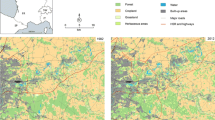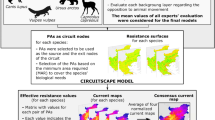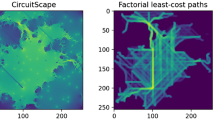Abstract
Species distribution models (SDMs) are commonly used in ecology to map the probability of species occurrence on the basis of predictive factors describing the physical environment. We propose an improvement on SDMs by using graph methods to quantify landscape connectivity. After (1) mapping the habitat suitable for a given species, this approach consists in (2) building a landscape graph, (3) computing patch-based connectivity metrics, (4) extrapolating the values of those metrics to any point of space, and (5) integrating those connectivity metrics into a predictive model of presence. For a given species, this method can be used to interpret the significance of the metrics in the models in terms of population structure. The method is illustrated here by the construction of an SDM for the European tree frog in the region of Franche-Comté (France). The results show that the connectivity metrics improve the explanatory power of the SDM and emphasize the important role of the habitat network.




Similar content being viewed by others
References
Armstrong DP (2005) Integrating the metapopulation and habitat paradigms for understanding broad-scale declines of species. Conserv Biol 19(5):1402–1410
Arthur SM, Manly BFJ, McDonald LL, Garner GW (1996) Assessing habitat selection when availability changes. Ecology 77:215–227
Austin MP (2002) Spatial prediction of species distribution: an interface between ecological theory and statistical modelling. Ecol Model 157:101–118
Bodin O (2009) Prioritizing habitat patches for conservation in fragmented landscapes/townscapes using network-based models and analyses. In: Brebbia CA, Neophytou M, Beriatos E, Ioannou I, Kungolos AG (eds) Sustainable development and planning. Wit Press, Southampton, pp 109–118
Bodin O, Saura S (2010) Ranking individual habitat patches as connectivity providers: integrating network analysis and patch removal experiments. Ecol Model 221:2393–2405
Borgatti SP (2005) Centrality and network flow. Soc Netw 27:55–71
Borgula A (1993) Causes of the decline in Hyla arborea. In: Stumpel A, Tester U (eds) Ecology and conservation of the European tree frog, 1st international workshop on Hyla arborea, Postdam, February 1992, Schweizerischer Bund für Naturschutz, Basel, pp 71–80
Bunn AG, Urban DL, Keitt TH (2000) Landscape connectivity: a conservation application of graph theory. J Environ Manag 59:265–278
Calabrese JM, Fagan WF (2004) A comparison-shopper’s guide to connectivity metrics. Front Ecol Environ 2(10):529–536
Carlson A, Edenhamn P (2000) Extinction dynamics and the regional persistence of a tree frog metapopulation. Proc R Soc Lond B 267:1311–1313
Dale MRT, Fortin MJ (2010) From graphs to spatial graphs. Annu Rev Ecol Evol Syst 41:21–38
Estrada E, Bodin O (2008) Using network centrality measures to manage landscape connectivity. Ecol Appl 18:1810–1825
Fahrig L, Grez AA (1996) Population spatial structure, human-caused landscape changes and species survival. Rev Chil Hist Nat 69(1):5–13
Fog K (1993) Migration in the tree frog Hyla arborea. In: Stumpel A, Tester U (eds) Ecology and conservation of the European tree frog. 1st international workshop on Hyla arborea, Potsdam, February 1992, Schweizerischer Bund für Naturschutz, Basel, pp 55–63
Franklin J (2009) Mapping species distributions. Cambridge University Press, Cambridge
Galpern P, Manseau M, Fall A (2011) Patch-based graphs of landscape connectivity: a guide to construction, analysis and application for conservation. Biol Conserv 144:44–55
Guisan A, Thuillier W (2005) Predicting species distribution: offering more than simple habitat models. Ecol Lett 8:993–1009
Guisan A, Zimmermann NE (2000) Predictive habitat distribution models in ecology. Ecol Model 135:147–186
Gustafson EJ, Parker GR (1994) Using an index of habitat patch proximity for landscape design. Landsc Urban Plan 29:117–130
Hanski I, Ovaslaken O (2000) The metapopulation capacity of a fragmented landscape. Nature 404:755–758
Hirzel AH, Arlettaz R (2003) Modelling habitat suitability for complex species distributions by environmental-distance geometric mean. Environ Manag 32(5):614–623
Hirzel AH, Le Lay G (2008) Habitat suitability modelling and niche theory. J Appl Ecol 45:1372–1381
Hjermann DØ (2000) Analyzing habitat selection in animals without well-defined home ranges. Ecology 81:1462–1468
Kindlmann P, Burel F (2008) Connectivity measures: a review. Landscape Ecol 23:879–890
Matthiopoulos J (2003) The use of space by animals as a function of accessibility and preference. Ecol Model 159:239–268
Minor ES, Urban DL (2007) Graph theory as a proxy for spatially explicit population models in conservation planning. Ecol Appl 17:1771–1782
Minor SM, Urban DL (2008) A graph-theory framework for evaluating landscape connectivity and conservation planning. Conserv Biol 22:297–307
Moilanen A (2011) On the limitations of graph-theoretic connectivity in spatial ecology and conservation. J Appl Ecol. doi:10.1111/j.1365-2664.2011.02062.x
Pellet J, Hoehn S, Perrin N (2004) Multiscale determinants of tree frog (Hyla arborea L.) calling ponds in western Switzerland. Biodivers Conserv 13:2227–2235
Pinston H (2000) Amphibiens et Reptiles de Franche-Comté. Atlas commenté de Répartition. Conseil Régional de Franche-Comté, Besançon
Pulliam HR (1988) Sources, sinks and, population regulation. Am Nat 132:652–661
Richard Y, Armstrong DP (2010) The importance of integrating landscape ecology in habitat models: isolation-driven occurrence of north island robins in a fragmented landscape. Landscape Ecol 25:1363–1374
Saura S, Pascual-Hortal L (2007) A new habitat availability index to integrate connectivity in landscape conservation planning: comparison with existing indices and application to a case study. Landsc Urban Plan 83:91–103
Tscharntke T, Klein AM, Kruess A, Steffan-Dewenter I, Thies C (2005) Landscape perspectives on agricultural intensification and biodiversity–ecosystem service management. Ecol Lett 8:857–874
Urban DL, Keitt TH (2001) Landscape connectivity: a graph theoretic approach. Ecology 82:1205–1218
Urban DL, Minor ES, Treml EA, Schick RS (2009) Graph models of land mosaics. Ecol Lett 12:260–273
Vos C, Stumpel AHP (1995) Comparison of habitat-isolation parameters in relation to fragmented distribution patterns in the tree frog (Hyla arborea). Landscape Ecol 11:203–214
Wright KA (1943) Isolation by distance. Genetics 28:114–138
Zetterberg A, Mörtberg UM, Balfors B (2010) Making graph theory operational for landscape ecological assessments, planning, and design. Landsc Urban Plan 95:181–191
Acknowledgments
The authors thank Timothy Keitt and two anonymous reviewers for their valuable comments. This research is funded by the French Ministry of Ecology, Energy, Sustainable Development and the Sea (ITTECOP program) as part of the Graphab project managed by the USR 3124 MSHE Ledoux. Computations were performed on the supercomputer facilities of the “Mésocentre de calcul de FrancheComté”. We thank Raanan Barzel and Christopher Sutcliffe for reviewing the English manuscript.
Author information
Authors and Affiliations
Corresponding author
Rights and permissions
About this article
Cite this article
Foltête, JC., Clauzel, C., Vuidel, G. et al. Integrating graph-based connectivity metrics into species distribution models. Landscape Ecol 27, 557–569 (2012). https://doi.org/10.1007/s10980-012-9709-4
Received:
Accepted:
Published:
Issue Date:
DOI: https://doi.org/10.1007/s10980-012-9709-4




